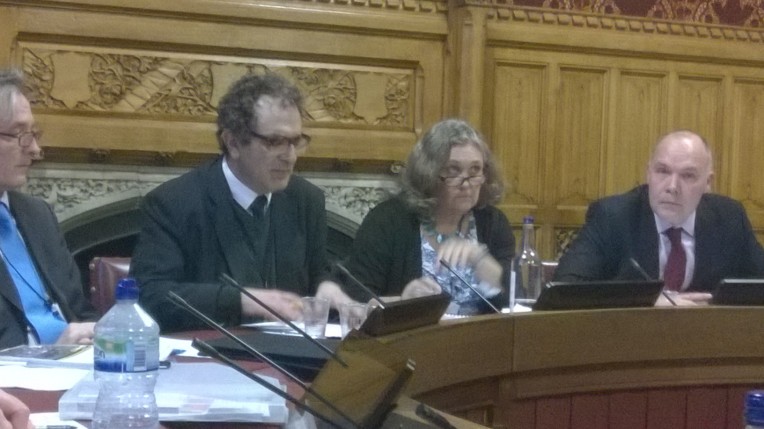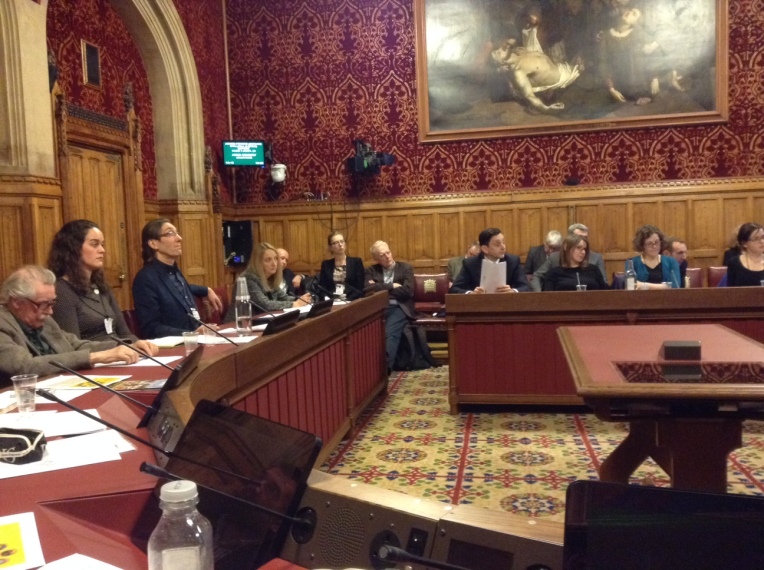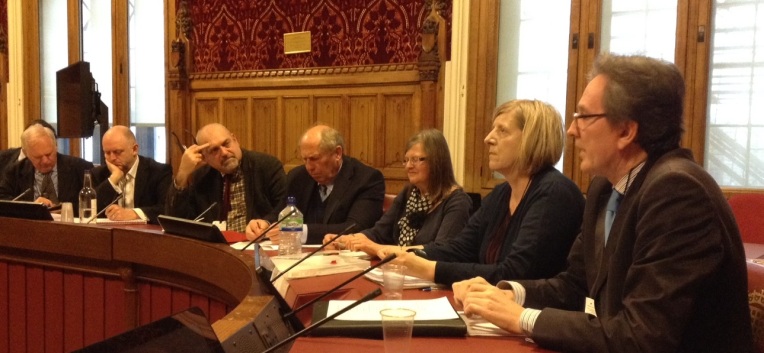The first New Garden Cities Alliance round-table meeting has proved a great success and the prospects of producing an accreditation system for garden cities moved a step closer.
Lord Glasman welcomed a packed room of architects, planners and community groups and institutions. Attendees included Wolfson prize winners and shortlisted entries – Urbed, Shelter, Barton Willmore, Golding Homes and Wei Yang & Partners.
Lord Glasman outlined that he considered the garden city agenda to be bigger than any single political party and the goal is to build on the cross party consensus that is already forming.
Philip Ross, the former Mayor of Letchworth Garden City, and co-founder of the New Garden Cities Alliance spoke about the Letchworth Declaration. The Declaration, he explained had been published back in September and in summary asked the question “do we think that the term garden cities should mean something? and if so how can we make that happen?”. He said “ we do think it should stand for something and the goal of this meeting is to put us on the road to making it happen”. Philip delved into the roots of the garden city vision and the ‘dream that was Letchworth’. Explaining the success of Letchworth was in the combination of both its visible and invisible architecture with a particular focus on the issue of land value capture.
He said that there was a degree of urgency to create a protected definition of a garden city and that if the group failed to act then the government or the market would define it.
Debate on the subject suggested that a strong definition would raise standards for a place.
Next up Katy Lock from the TCPA outlined the TCPA garden city principles and explained how they had been derived and that the language used to communicate will vary depending on the audience. Basically if outlined to the general public and to a room of architects and planners, the principles would be the same but they way they are articulated would be different.
One of the myths around garden cities has been that they are all on green-field sites and this is why URBED’s winning entry for the Wolfson prize was so significant as it talked about extending an existing settlement and controversially invading some of the green belt. Nick Falk from URBED explained this in more detail.
A wide ranging discussion followed on both the garden city principles and the need for democratic structures and so some debate about the difference between getting a garden city and how to run it.
Time constraints meant that the chairman moved on to a presentation about how an accreditation process could work. Liz Wrigley explained how the ‘Building for Life’ scheme had been established and was operated. Unfortunately Robin Murray who had been scheduled to talk about the fair trade accreditation scheme had been taken ill. He sent some notes to Philip Ross who précised them to the meeting. Philip added that the strength of an accreditation scheme to garden cities was in its desirability and commercial implications to developments that couldn’t get it. This would be a driver to developers to seek to gain it. It was noted from the floor that such an accreditation process could be linked to finance and that would make it very powerful (the NGCA will try to arrange further discussion on this area). It was noted also that Howard had raised money from insurance companies to help finance Letchworth on the basis that new home owners would all need insurance.
In terms of how the Alliance could operate Thomas Hoepfner outlined that the New Garden Cities Alliance had been established as community-interest company. That the steps going forward were to agree on how the organisation should operate and that it should be complementary to existing institutions and not in competition with them.
Chairman Patricia Nevins outlined the next steps which were to establish three working parties to look at the areas of ‘Principles and evolution’, ‘Accreditation’ and thirdly ‘operations’. An email would be sent out to attendees inviting them to join the groups which would operate through on-line discussions and physical meetings.
The Chairman asked those present if there was general agreement to the proposed course of action and on a show of hands it was overwhelmingly endorsed. The Chairman encouraged those present to raise any reservations, dissension or adverse comment and none were raised. The meeting agreed that the Working Groups were therefore fully mandated to bring their proposals to the next meeting of the alliance , which it is hoped will take place in June.
It was noted that Lord Glasman offered to host a further meeting of Alliance which was mooted for late June (to give any new government or coalition a chance to settle in).
The chairman thanked everyone for their attendance and for what had been a very successful event.
The meeting closed promptly at 16:30.






To counter the myth that Garden cities are limited to greenfield sites do we need to expand their name somehow to recognise how their distinctive invisible architecture improves the common good?
LikeLike
Yes, sure. One of the main points we have to communicate.
LikeLike
That is a good question to consider.
May I offer some thoughts;
There was a short, but interesting article published recently about an eco-village within the city of Los Angeles, here is the link: http://bit.ly/1Fgw1cv
And just yesterday this article, also from L.A. http://bit.ly/1GxHDWt
Was it agreed that the principles of the Garden City can be applied in the remediation and amelioration of existing cities equally as well as to new-builds? And, is this to be adopted as a directive for communities and Councils should they choose?
Many neighborhoods can be elevated by employing, or re-engaging with Garden City principles – for instance, something as simple as the planting and growing of wild flowers and blossoming fruiting trees (or any trees) – completely transform a place – brings people together in creative activity and this also raises land and property value.
Fruit trees are good in public spaces, they have an invisible message – of being a common good and giving freely. Blossoming, providing, generative, fruitful – all good character traits !
There is a great video available for free-view, for just a few days, which may be of interest, from Geoff Lawton. In this video he shows lots of approaches which can be taken to achieving Garden City principles. The link is here: http://fb.me/1vxAd6BH8
A quote from Bruce H Lipton PhD, (he’s an evolutionary biologist from the USA)
“..our evolution is not an evolution of individuals, but an evolution of communities… When we create humanity, which is when we all recognize that we are all cells in the same living organism, and work in a coherent fashion, we have then created the next level of evolution… evolution is not on the individual basis, but once we come together in community,”
This, perhaps sounds communistic, socialistic, but taken from a biologist, we can agree that the cells in our body work harmoniously, and coherently, without supervision. Perhaps rather, for a common spirit. 1 Cor 12:12-24 for this. I’m not a bible expert, but stumbled across this. The same principle is reiterated by scholars such as St Thomas Aquinas, Marcus Aurelius, Santideva, Alexander Pope and perhaps more. We can see there are people akin with this understanding http://on.fb.me/1F63qpM.
Personally I’ve a lot of work to do – toward community, however not alone. I feel we are amidst an egregore that is urging us to reconnect with the natural systems of the Earth and with each other. There is a genuine need and genuine hope among people for positive change for both communities and the environment.
The realisation of Garden City principles, using a permaculture design approach for instance, employed by architects, engineers, planners, builders, gardeners, diy-ers, farmers, teachers and so on, can rejuvenate economies, environments and communities. We are blessed with incredible digital resources at our fingertips for learning and communication. Once we’ve defined a plan that’s agreeable at all levels, its very possible to communicate how a transition can take place, and how to do it, even with daily internet classes in anything from gardening and building techniques (or tasks), to meditation techniques – who knows!? It has to be about people and the earth if we are to rekindle prosperity, for the soil is becoming exhausted from all this mowing and fertilizing and mowing of nothing more than grass which is then discarded. We can harvest way more from the earth and it doesn’t need to be at a loss to anyone.
Garden City is a great term – it unites the current poles of Rural-Urban, Nature-Human, Ecological-Technological, Undeveloped-Developed and so on. Also everyone understands the term – we all, are familiar with both notions. If we were to use for instance a term like “urban re-vegetalisation,” it’s a bit dry, but “Garden City” engages the imagination.
E.g. Teacher: “right kids, your next challenge is to all draw a garden city!” But if the teacher said to “draw the ecological transition of urban environments,” there might be a few blank faces!
LikeLike
Thank you for the input. Please join one of our soon announced working groups for the topics principles, accreditation or operations.
The video with Geoff Lawton about urban permaculture is now available here: https://youtu.be/cZT4zDJHO2Y
LikeLike
Essential Listening/Reading
Short Video Presentation from Geoff Lawton re Urban Developments:
http://permaculturenews.org/2015/03/28/geoff-lawton-on-urban-agriculture/
References:
Village Homes – designed by Michael Corbett
Masterplan description:
http://www.michaelcorbettmasterbuilder.com/village.html
Video Tours:
http://www.ecofilms.com.au/americas-forgotten-food-forest-suburb-rediscovered/
Video Interview with Architect Michael Corbett:
Permaculture Designers Manuel by Bill Mollison (Chapter 14 referred to by Geoff Lawton):
http://www.eco-logicbooks.com/product/permaculture-designers-manual/
LikeLike